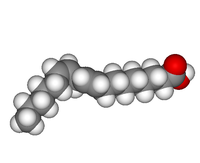
Photo from wikipedia
The interactions between fatty acids (FA) classes: polyunsaturated (PUFA-ω6, PUFA-ω3), saturated (SFA), EPA (eicosapentaenoic acid-ω3), DHA (docosahexaenoic-ω3) and cardiometabolic syndrome (CMS) clusters, thrombosis development and vascular inflammation are subtle. This… Click to show full abstract
The interactions between fatty acids (FA) classes: polyunsaturated (PUFA-ω6, PUFA-ω3), saturated (SFA), EPA (eicosapentaenoic acid-ω3), DHA (docosahexaenoic-ω3) and cardiometabolic syndrome (CMS) clusters, thrombosis development and vascular inflammation are subtle. This relationship is mediated by insulin resistance (IR), endothelial dysfunction, platelet aggregation disorder and atherosclerosis. OBJECTIVES We investigated whether PUFA/SFA - PUFA-ω6/PUFA-ω3 ratios and EPA + DHA can be associated with predictive atherothrombogenic biomarkers status in type 2 diabetes (T2D) patients with or without hypertension (HT). The study was conducted on 507 adult subjects (men and women) cohort (36-54 years), divided into 3 groups: T2D, diabetic-hypertensive (DH) and healthy group. Patients were phenotyped regarding their CMS profile using the NCEP/ATPIII criteria. Hypertension was defined as systolic (SBP) and diastolic (DBP) blood pressure ≥140/90 mmHg, respectively. Insulin resistance was assessed by Homa-IR model. Metabolic, atherothrombogenic and inflammatory parameters (CRP) were analyzed by various automata; Non-esterified fatty acids (NEFA) by microfluorimetry; PUFA-ω6 and PUFA-ω3 by gas phase chromatography. CMS clusters and IR were found in T2D and DH groups. Dyslipidemia was correlated with accretion NEFA levels. The PUFA/SFA ratio and PUFA-ω3 level are decreased, concomitant with an increase ApoB100/ApoA1 ratio and very high lipoprotein (a) concentrations. Raising the PUFA-ω6/PUFA-ω3 ratio and PUFA-ω6 levels were associated with the drop HDL-c/LDL-c ratio and EPA+DHA drastic depletion. In conclusion, fatty acids nutritional quality may be associated with atherothrombogenic biomarkers, mainly Lp (a), to prevent the thrombosis and an accident vascular risk in diabetic-hypertensive subjects.
Journal Title: Annales de biologie clinique
Year Published: 2017
Link to full text (if available)
Share on Social Media: Sign Up to like & get
recommendations!